...Best of Sicily presents... Best of Sicily Magazine. ... Dedicated to Sicilian art, culture, history, people, places and all things Sicilian. |
by L. Mendola and V. Salerno | |||||
Magazine Index Best of Sicily Arts & Culture Fashion Food & Wine History & Society About Us Travel Faqs Contact Map of Sicily
|
The Arabs, who in medieval times were sometimes called "Saracens" or "Moors," have been identified since antiquity (in Assyrian records dated to circa 850 BC), but until the Middle Ages they were not unified as a people. In the Early Middle Ages, it was Islam that united the Arabs and established the framework of Islamic law, which may have influenced European legal principles as far away as the Norman Kingdom of England and its common law. Initially, most Muslims were Arabs, and during the Arab rule of Sicily their Islamic faith was closely identified with them. (Even today, many principles believed to be tenets of Islam are, in fact, Arab practices unrelated to Muslim ethics.) The rapid growth of Arab culture could be said to parallel the dissemination of Islam. Except for some poetry, the first major work of literature published entirely in Arabic was the Koran (Quran), the holy book of Islam, and one may loosely define Arabs by the regions where Arabic was spoken in the Middle Ages and afterwards. Arabs were a Semitic people of the Middle East. The Berbers of northwest Africa and the Sahara were not Arabs, though many converted to Islam, adopted Arabic as their language and assimilated with Arab society. Though most parts of Sicily were conquered by Arabs, certain areas where settled by people who, strictly speaking, were Muslim Berbers. Like many Berbers, some Arabs were nomadic. With the emergence of the Byzantine Empire, groups of Arabs lived in bordering areas in the Arabian peninsula and parts of what are now Iraq, Kuwait, Jordan and Egypt. Their language, Arabic, is a Semitic tongue of various dialects related to Hebrew and Ethiopic, written in script from right to left. Muhammad (the Prophet of Islam) was born in Mecca around AD 570 and his religious community at Medina eventually grew to dominate the entire Arabian peninsula. Following Muhammad's death in 632, caliphs (civil and religious leaders) succeeded him. Three families from Muhammad's tribe ruled the expanding Arabian empire for the next few centuries, namely the Umayyads (661-750), the Abbasids (750-850) and the Alids (Fatimid dynasty in northern Africa from 909 to 1171). In practice, certain regions - including Sicily - were actually controlled by particular (if minor) families, or often under local emirs (there were several in Sicily when the Normans arrived in 1061). Initially, the Arabs aspired to little more than some productive land in coastal areas and around the Fertile Crescent of the Middle East, but within decades of the Prophet's death their objectives grew greater. With the growth of their society supported by conversions to Islam, the wealth sought by Arabs was precisely that which the Koran (3:14) discouraged: "The passion for women, the desire for male children, the thirst for gold and silver, spirited horses, and the possession of cattle and land, in fact all the pleasures of life on earth." Sicily offered all of these things in abundance. By 650, the Arabs were making their way through Libya and Tunisia, and
Three Arab dynasties ruled Sicily - first the Aghlabids (a "minor" family based in Tunisia which had broken away from the Abbasids of Baghdad) and then, from 909, the Fatimids, who entrusted much of their authority to the Kalbids in 948. In that year, Hassan al-Kalbi became the first Emir of All Sicily. By 969, the Fatimid dynasty (descended from the Prophet's daughter, Fatima) were moving their geographic center of power to Cairo, leaving their Tunisian capitals (Madiyah and Al Quayrawan) and western territories to the care of what in Europe would be called "vassals." Islam spread quickly across the Mediterranean but in Sicily the Arabs' conquest was a slow one. Panormos, which was to become the seat of an emirate as Bal'harm (Palermo) in 948, fell in 832. Messina was taken in 843. Enna (the Arabs' Kasr' Yanni, also an emirate) was conquered in 858. With the violent fall of Syracuse in 878, the conquest was essentially complete, though Taormina and several other mountaintop communities held out for a few more years. Byzantine society, culture and government were closely identified with Christianity, and the law was based largely (though not entirely) on Judeo-Christian ideas, but it would have been mistaken to consider the Byzantine state a theocracy. Moreover, as Christianity already existed in many regions (such as Sicily) in the Byzantine Empire, there was not always a need to introduce (or impose) it. Islam, however, was a way of life that could not easily be separated from society itself, and it was a religion formerly unknown in Sicily. This obviously influenced Arab society in Sicily and elsewhere, though efforts were made to retain something of the established order. In the early ninth century, Islam itself could be said to be in its formative stages socially, with certain literary sources (collections of hadiths containing sunnahs or "laws") still being written. Arab administration, if not particularly enlightened, was not very harsh by medieval standards, but it was far from egalitarian. Sicily's Christians and Jews (Sicily was at least half Muslim by 1060) were highly taxed, and clergy could not recite from the Bible or Talmud within earshot of Muslims. Christian and Jewish women (who like Muslim ones were veiled in public) could not share the public baths with Muslim women -many of whom were ex-Christians converted to Islam to contract financially or socially advantageous marriages to Muslim men. Non-Muslims had to stand in the presence of Muslims. New churches and synagogues could not be built, nor Muslims converted to other faiths. A number of large churches, such as the cathedral of Palermo, were converted to mosques. (The Arabic inscription shown above is still visible on one of its columns.) A degree of religious tolerance prevailed; there were no forced conversions. Yet, a new social order was soon in place. Except for a few merchants and sailors, there had been very few Muslim Arabs in Sicily before 827, but Byzantine legal strictures imposed upon them, and upon the Jews living across the island, cannot be said to have been as rigid as those imposed upon non-Muslims by the Arabs after about 850. At first, however, many Sicilians probably welcomed the prospect of change because they had been overtaxed and over-governed by their Byzantine rulers. The Arabs introduced superior irrigation systems; some of their underground qanats (kanats) still flow under Palermo. They established the Sicilian silk industry, and at the court of the Norman monarch Roger II great Arab thinkers like the geographer Abdullah al Idrisi were welcome. Agriculture became more varied and more efficient, with the widespread introduction of rice, sugar cane, cotton and oranges. This, in turn, influenced Sicilian cuisine. Many of the most popular Sicilian foods trace their origins to the Arab period. Dozens of towns were founded or resettled during the Saracen era, and souks (suks, or street markets) became more common than before. Bal'harm (Palermo) was repopulated and became one of the largest Arab cities after Baghdad and Cordoba (Cordova), and one of the most beautiful. Construction on Bal'harm's al-Khalesa district built near the sea was begun in 937 by Khalid Ibn Ishaq, who was then Governor of Sicily. Despite later estimates of a greater population, there were probably about two hundred thousand residents in and around this city by 1050, and it was the capital of Saracen Sicily. Bal'harm was the official residence of the Governors and Emirs of All Sicily, and al-Khalesa (now the Kalsa district) was its administrative center. As we've mentioned, in 948 the Fatimids granted a degree of autonomy to the Kalbid dynasty, whose last "governor" (effectively a hereditary emir), Hasan II (or Al-Samsan), ruled until 1053. By then, Kasyr Yanni (Enna), Trapani, Taormina and Syracuse were also self-declared, localized "emirates." (This word was sometimes used rather loosely to describe any hereditary ruler of a large locality; in law Sicily had been a unified emirate governed from Palermo since 948, but by the 1050s the others had challenged his authority over them.) Naturally, Arabic was widely spoken and it was a major influence on Sicilian, which emerged as a Romance (Latin) language during the subsequent (Norman) era. The Sicilian vernacular was in constant evolution, but until the arrival of the Arabs the most popular language in Sicily was a dialect of Greek. Under the Moors Sicily actually became a polyglot community; some localities were more Greek-speaking while others were predominantly Arabic-speaking. Mosques stood alongside churches and synagogues. Arab Sicily, by 948 governed from Bal'harm with little intervention from Qayrawan (Kairouan), was one of Europe's most prosperous regions --intellectually, artistically and economically. (At the same time, Moorish Spain was comparable to Sicily in these respects, but its prior society had been essentially Visigothic rather than Byzantine.) With the exception of occasional landings in Calabria, the Sicilian Arabs coexisted peacefully with the peoples of the Italian peninsula. These were Lombards (Longobard descendants) and Byzantines in Calabria, Basilicata and Apulia, where Bari was the largest city. Under the Byzantines' empire, Sicily enjoyed some contact with the East, but as part of a larger Arab empire having greater contact with China and India, Far Eastern developments such as paper (made from cotton or wood), the compass and Arabic numerals (actually Indian) arrived. So did Arab inventions, such as henna - though today's middle-class Sicilian obsession with artficial blondness is a twentieth-century phenomenon. Under the Arabs, Sicily and Spain found themselves highly developed compared to England and Continental northern Europe. Byzantium hadn't forgotten Sicily, and in 1038 George Maniakes, at the head of an army of Byzantine-Greeks, Normans, Vikings and Lombards, attempted an invasion of Sicily without success. By the 1050s, the Pope, and some Norman knights from this failed adventure, were casting a long
glance toward Sicily with an eye to conquest. This desire was later fueled
by dissension among the island's Arabs, leading to support by the Emir of
Syracuse for the Normans against the emirates of Enna and The Normans conquered Messina in 1061 and reached the gates of Palermo a decade later, removing from power the local emir, Yusuf Ibn Abdallah, but respecting Arab customs. Their conquest of Arab Sicily was slower than their conquest of Saxon England, which began in 1066 with the Battle of Hastings. Kasr Yanni was still ruled by its emir, Ibn Al-Hawas, who held out for years. His successor, Ibn Hamud, surrendered, and converted to Christianity, only in 1087. Initially, and for over a century, the Normans' Sicilian kingdom was the medieval epitome of multicultural tolerance. By 1200, this was beginning to change. While the Muslim-Arab influence continued well into the Norman era - particularly in art and architecture - it was not to endure. The Normans gradually "Latinized" Sicily, and this social process laid the groundwork for the introduction of Catholicism (as opposed to eastern Orthodoxy). Widespread conversion ensued, and by the 1280s there were few - if any - Muslims in Sicily. Yet, the mass immigration of north-African Arabs (and Berbers) was the greatest Sicilian immigration since that of the ancient Greeks, leaving today's Sicilians as Saracen as Hellenic. While Norman government and law in Sicily were essentially European, introducing institutions such as the feudal system, at first they were profoundly influenced by Arab (and even Islamic) practices. Many statutes were universal, but in the earliest Norman period each Sicilian --Muslim, Christian, Jew-- was judged by the laws of his or her own faith. When did the various Sicilian localities cease to be Arab (or Byzantine Greek)? There was not an immediate change. Following the Norman conquest, complete Latinization, fostered largely by the Roman Church and its liturgy, took the better part of two centuries, and even then there remained pockets of Byzantine influence in northeastern Sicily's Nebrodi Mountains. Had the Normans not conquered Sicily, it might have evolved into an essentially Arab society not unlike that which survived in some parts of Spain into the later centuries of the Middle Ages, and the Sicilian vernacular language (as we know it) would have developed later. It is interesting to consider that general functional literacy among Sicilians was higher in 870 under the Arabs and Byzantines than it was in 1870 under the Italians (at about seventeen percent). In certain social respects, nineteenth-century Sicily still seemed very Arab, especially outside the largest cities, well into the early years of the twentieth century. About the Authors: Luigi Mendola is the History Editor of Best of Sicily and author of several books. Palermo native Vincenzo Salerno, who contributed to this article, has written biographies of several famous Sicilians, including Frederick II and Giuseppe di Lampedusa. | ||||
Top of Page |
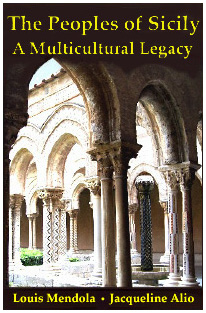
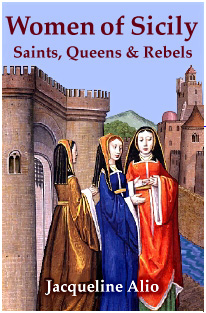
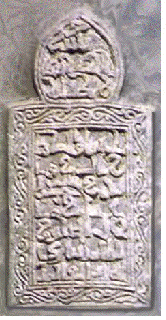 They ruled Sicily for two centuries and a few decades but their
influence was nothing short of monumental. Under their administration, the
island's population doubled as dozens of towns were founded and cities repopulated.
The Arabs changed Sicilian agriculture and cuisine. Their scientific
and engineering achievements were remarkable. More significantly, they changed
society itself. To this day, many Sicilian social attitudes reflect the
profound influence - often in subtle ways - of the Arabs who ruled a thousand
years ago but who (with the
They ruled Sicily for two centuries and a few decades but their
influence was nothing short of monumental. Under their administration, the
island's population doubled as dozens of towns were founded and cities repopulated.
The Arabs changed Sicilian agriculture and cuisine. Their scientific
and engineering achievements were remarkable. More significantly, they changed
society itself. To this day, many Sicilian social attitudes reflect the
profound influence - often in subtle ways - of the Arabs who ruled a thousand
years ago but who (with the 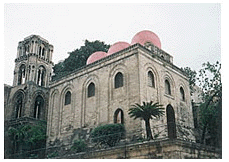 what remained of the once-prosperous city of Carthage was destroyed
in 698. The
what remained of the once-prosperous city of Carthage was destroyed
in 698. The 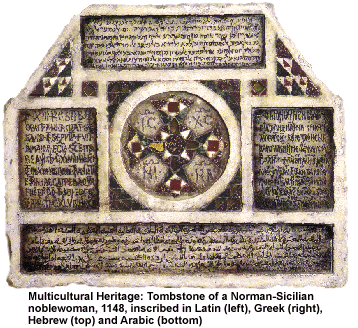 Palermo. Most
of these internal problems developed after the ruling Fatimids moved their
capital from Tunisia to Egypt, where they established Cairo (near ancient
Memphis).
Palermo. Most
of these internal problems developed after the ruling Fatimids moved their
capital from Tunisia to Egypt, where they established Cairo (near ancient
Memphis).